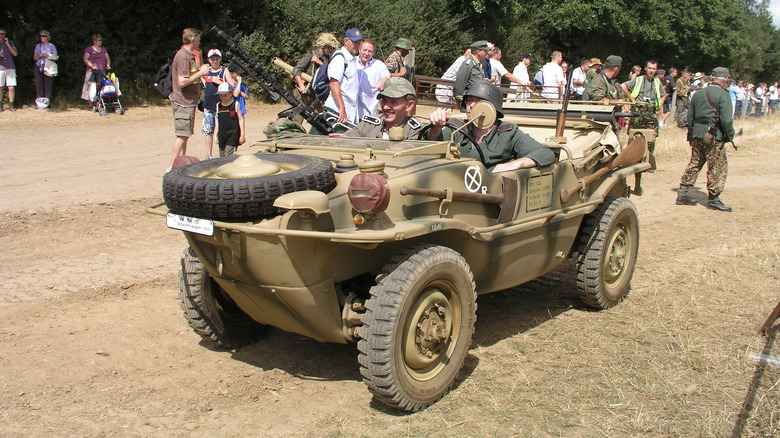The Volkswagen Schwimmwagen Is An Incredible Amphibious Car We Wish We Could Drive Today
Volkswagen has a long tradition of making cars that don't quite fit within the standard automotive design box, and it's something they've been doing since the very beginning. From the Beatle to the Thing, the German car maker always seemed intent on producing cars that only a mother could love. And while the Schwimmwagen certainly makes a case for being yet another ugly duckling, it's one we'd love to drive.
Like many of Volkswagen's early cars, the Schwimmwagen was built so Adolf Hitler's war machine could spread across any terrain on the European battlefield. Despite the moral dilemma behind their origins, the historical significance of VW's innovations during World War II can't be understated.
Between 1941 and 1944, approximately 15,500 Schwimmwagens were built (via Military Factory), making it the single "most mass-produced amphibious car in history" (via Dyler). Most of these "swimming cars" were either destroyed during the war or sat in fields or old buildings and eventually just rusted away. While an exact number isn't known, it's believed that as few as 150 exist today, but there could be as many as 500 still out in the wild. That's not many given the original production numbers of this "bathtub on wheels."
The Schwimmwagen actually had two versions, both designed by Erwin Komenda, who would go on to create Porsches 356 and 550 and help develop the 911 (via Silodrome). The Schwimmwagen was labeled "Type 166." It's prototype for testing, however, was "Type 128."
Volkswagen turned the Kübelwagen into the Schwimmwagen
It was basically just a heavily modified VW Army Kübelwagen chassis with a water-tight "bathtub" welded to the frame (via Military Factory). About 30 of these early Type 128 models were made (via Dyler), and while they proved successful, some modifications were needed. Type 166 was beefed up to provide better off-roading capabilities, as the 128 had proven to be somewhat fragile and encountered ruptures in the hull too frequently.
The 166 had a shorter wheelbase, and the 4-cylinder air-cooled 1.1-liter engine sat in the rear producing only 25hp (via Dyler). It was more or less the same engine used in the VW Beetle and Kübelwagen (via Silodrome). By comparison, the American-made Willys MB used by the United States Army kicked out 60hp (via Military Factory). The 5-speed transmission had four "normal" gears with a fifth "crawl" gear (via Dyler), and the four-wheel drive feature could only be used while in first gear (via Military Factory).
Once submerged, the four-passenger 166 moved through the water by use of a single propeller set on the back of the vehicle and could easily be lowered by hand. The prop's spin rate was controlled through the gas pedal, making it go faster when needed, while the front wheels acted as rudders to control the direction. If the engine failed to operate, paddles attached to each side allowed passengers to row, row, row their boat to shore (via Military Factory).
The war produced some genuinely odd amphibious vehicles, it's hardly a wonder that their popularity sunk when it was over.
